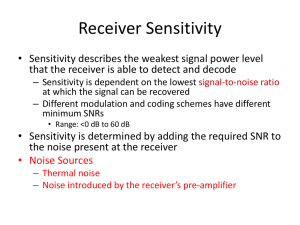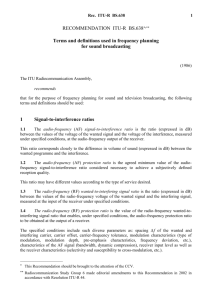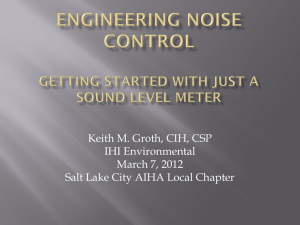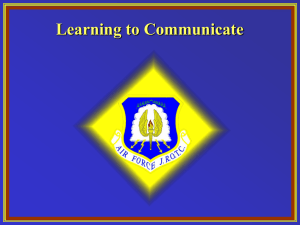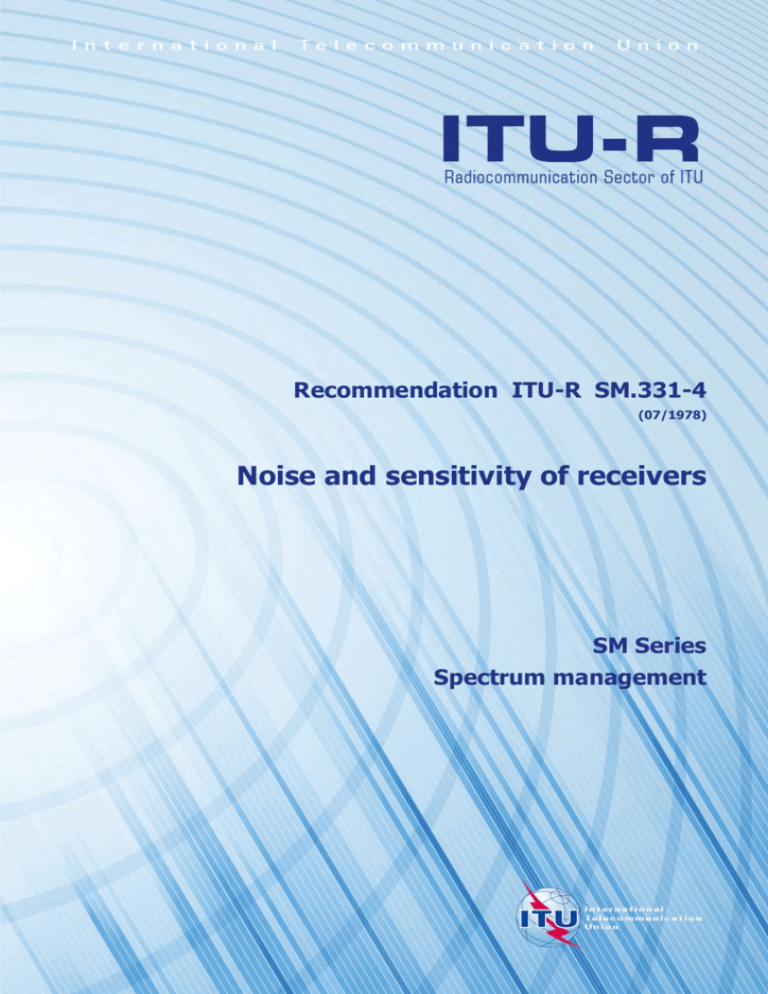
Recommendation ITU-R SM.331-4
(07/1978)
Noise and sensitivity of receivers
SM Series
Spectrum management
ii
Rec. ITU-R SM.331-4
Foreword
The role of the Radiocommunication Sector is to ensure the rational, equitable, efficient and economical use of the
radio-frequency spectrum by all radiocommunication services, including satellite services, and carry out studies without
limit of frequency range on the basis of which Recommendations are adopted.
The regulatory and policy functions of the Radiocommunication Sector are performed by World and Regional
Radiocommunication Conferences and Radiocommunication Assemblies supported by Study Groups.
Policy on Intellectual Property Right (IPR)
ITU-R policy on IPR is described in the Common Patent Policy for ITU-T/ITU-R/ISO/IEC referenced in Annex 1 of
Resolution ITU-R 1. Forms to be used for the submission of patent statements and licensing declarations by patent
holders are available from http://www.itu.int/ITU-R/go/patents/en where the Guidelines for Implementation of the
Common Patent Policy for ITU-T/ITU-R/ISO/IEC and the ITU-R patent information database can also be found.
Series of ITU-R Recommendations
(Also available online at http://www.itu.int/publ/R-REC/en)
Series
BO
BR
BS
BT
F
M
P
RA
RS
S
SA
SF
SM
SNG
TF
V
Title
Satellite delivery
Recording for production, archival and play-out; film for television
Broadcasting service (sound)
Broadcasting service (television)
Fixed service
Mobile, radiodetermination, amateur and related satellite services
Radiowave propagation
Radio astronomy
Remote sensing systems
Fixed-satellite service
Space applications and meteorology
Frequency sharing and coordination between fixed-satellite and fixed service systems
Spectrum management
Satellite news gathering
Time signals and frequency standards emissions
Vocabulary and related subjects
Note: This ITU-R Recommendation was approved in English under the procedure detailed in Resolution ITU-R 1.
Electronic Publication
Geneva, 2011
ITU 2011
All rights reserved. No part of this publication may be reproduced, by any means whatsoever, without written permission of ITU.
Rec. ITU-R SM.331-4
1
RECOMMENDATION ITU-R SM.331-4*
NOISE AND SENSITIVITY OF RECEIVERS
(1951-1953-1956-1959-1963-1966-1970-1974-1978)
Rec. ITU-R SM.331-4
The ITU Radiocommunication Assembly,
considering
(a)
that the sensitivity of a receiver is a measure of its ability to receive weak signals and to produce an output
having usable strength and acceptable quality; in many cases, to assess the quality of the output, it might be necessary to
take into consideration the receiving equipment as a whole, including the parts giving the information in a printed, aural
or visual form;
(b)
that the following parameters, which are determined by the particular service for which the receiver is used, are
of special importance in relation to sensitivity;
–
necessary output level;
–
necessary overall signal bandwidth;
–
necessary signal-to-noise ratio at the output;
(c)
that the following parameters relating to the internal noise of the receiver, which are determined by the receiver
design, are also of importance in relation to the sensitivity of the receiver:
–
the level of the internal noise, as defined, for example, by the noise factor;
–
the width of the effective overall noise band, which is not necessarily identical with the width of the signal band
(see Recommendation ITU-R SM.332);
(d)
that, in many cases, to economize in transmitted power, it is desirable that the sensitivity shall be as great as
economic and technical considerations permit and justified by the external noise level;
(e)
that the conditions for obtaining high sensitivity, viz. the ability of the receiver to receive weak signals of the
desired transmission, should be considered in connection with those for obtaining good protection against interfering
signals (see Recommendation 332);
(f)
that additional data on noise factor and noise temperature for the various types of receiver used for reception of
different classes of emission in the different services are required;
(g)
that, for the purpose of presenting, comparing, and using data on the sensitivity of receivers, it is desirable to
define the following terms:
–
maximum usable (noise-limited) sensitivity;
–
maximum usable (gain-limited) sensitivity;
–
reference sensitivity;
–
noise factor or noise temperature;
(h)
that often values for noise factor or noise temperature are particularly useful, since they are more uniform than
values of maximum usable sensitivity for the various types of receiver used for the reception of different classes of
emission in the different services and, other factors remaining unchanged, indicate the degree of improvement in
maximum usable sensitivity which is theoretically possible;
(j)
that the noise factor or noise temperature is useful only for a linear receiver or for the linear part of a receiver,
since in a non-linear receiver the noise factor is dependent on the signal input level;
(k)
that reference sensitivity is chiefly of value in comparing linear receivers;
(l)
that it is desirable to define a “linear” receiver;
*
Radiocommunication Study Group 1 made editorial amendments to this Recommendation in 2011 and 2015 in accordance with
Resolution ITU-R 1.
2
(m)
Rec. ITU-R SM.331-4
that, for radiotelegraphy receivers for automatic reception:
–
the use of a non-linear demodulator, discriminator or telegraph shaping circuit, or the use of narrow-band filters
changes the effect of noise from an amplitude variation into a variation of the duration of the telegraph signal
elements at the output of the receiver (signal distortion);
–
noise may cause mutilation of the signals by splits or extras;
–
signal distortion and signal mutilation may cause erroneous characters in the reproduced text;
–
the foregoing considerations make it desirable to define receiver sensitivity with reference to signal distortion and
mutilation or character errors in the reproduced text;
(n)
that for sound broadcast and television receivers, it is desirable to define sensitivity not only for a reasonably
good output signal, but also for any usable output signal,
unanimously recommends
1.
that a linear receiver should be defined as one operating in such a manner that the signal-to-noise ratio at the
output is proportional to the signal level at the input, and/or to the degree of modulation;
2.
that the noise factor should be defined as follows: the noise factor is the ratio of noise power measured at the
output of the receiver to the noise power which would be present at the output if the thermal noise due to the resistive
component of the source impedance were the only source of noise in the system; both noise powers are determined at an
absolute temperature of the source equal to T = 293 K;
2.1
that the noise temperature be defined as the value by which the temperature of the resistive component of the
source impedance should be increased, if it were the only source of noise in the system, to cause the noise power at the
output of the receiver to be the same as in the real system;
3.
that the width of the effective overall noise band should be defined as the width of a rectangular frequency
response curve, having a height equal to the maximum height of the receiver frequency response curve and
corresponding to the same total noise power (see [CCIR, 1951]);
4.
that the maximum usable sensitivity should be defined as the larger of the minimum input signal levels
(expressed as the e.m.f. of the carrier) *, which must be applied in series with the specified source impedance (dummy
antenna) to the input of the receiver to produce at the output:
4.1
4.2
– the signal level
– the signal-to-noise ratio
necessary for normal operation when the normal degree of modulation**
is applied to the carrier
If the gain is sufficient to enable both conditions to be satisfied simultaneously, the maximum usable
sensitivity is described as “noise-limited”. Otherwise, the gain being insufficient, the maximum usable sensitivity is
described as “gain-limited”; in this case the gain, being adjusted to a maximum, enables the condition of § 4.1 (necessary
output level) to be satisfied without regard to the output noise level (condition of § 4.2);
4.3
–
the ratio of (signal + noise + distortion) to (noise + distortion) necessary for normal operation; or
4.4
–
the signal distortion or mutilation just acceptable for normal operation;
5.
that, for the purpose of presenting and comparing data for particular classes of linear receivers and classes of
emission for the different services (normally noise-limited) and for a particular frequency range, the reference sensitivity
should be defined as the maximum usable sensitivity for specified values of:
–
signal-to-noise ratio;
–
receiver bandwidth;
–
degree of modulation;
–
source impedance (dummy antenna).
*
For frequencies above about 30 MHz, the input signal strength is sometimes taken as the available power from the source.
** Classes of emission A1A and A1B are considered 100% modulated.
Rec. ITU-R SM.331-4
3
Within the linear range, the maximum usable sensitivity for any of these conditions should be derived from the
reference sensitivity (the noise factor being considered as constant), and vice versa (see Annex I);
6.
that in case of uncertainty with regard to terms of the formulae relating noise factor and reference sensitivity
(see Annex I), e.g. the width of the effective overall noise band, independently measured values for these two quantities
should be given;
7.
that values for the maximum usable sensitivity and for reference sensitivity should be considered in connection
with the values for the single signal and multiple signal selectivity (see Recommendation ITU-R SM.332);
8.
that, since the reference sensitivity is of particular value for a receiver working in a linear condition, for the
markedly non-linear condition only, the maximum usable sensitivity and the noise factor for the normal operating
conditions should be given;
9.
that, although radiotelegraph receivers for aural reception can be operated linearly, those for automatic
operation, in which non-linearity usually occurs, must be given separate consideration;
9.1
maximum usable sensitivity should be defined as the minimum input signal (expressed as the e.m.f. of the
carrier), which must be applied in series with the specified source impedance (dummy antenna), to the input of the
receiver to obtain at the output the desired signal level and the amount of signal distortion or mutilation permissible in
normal operation; the maximum usable sensitivity as defined above should be described as “distortion limited” or
“mutilation limited”;
9.2
maximum usable sensitivity, including the reproducing equipment, should be defined as the minimum input
signal (expressed as the e.m.f. of the carrier), which must be applied in series with the specified source impedance
(dummy antenna), to the input of the receiver to obtain a specified character error ratio in the reproduced text;
9.3
defined methods for measuring signal distortion, signal mutilation, element error ratios and character error
ratios should be used (see [CCIR, 1956; 1958a, b, c and CCIR, 1966-69a and b]);
9.4
for the purpose of comparing and presenting data (see Annex I, § 5), the maximum usable sensitivity should be
given for specified values of:
–
the amount of signal distortion and signal mutilation at the receiver output with a specified probability of occurrence
(see § 9.1 and Annex I, § 5.4); or the character error rate in the reproduced texts (see § 9.2 and Annex I, § 5.5) and
the receiver pre-detector and post-detector signal bandwidth;
–
the frequency shift for F1B emissions;
–
the source impedance (dummy antenna);
9.5
the performance of the receiving equipment in terms of signal distortion, signal mutilation or character error
rate, instead of being defined by the maximum usable sensitivity, is often described by the signal-to-noise power ratio
value in the receiver, just prior to the non-linear part; in this case, it is convenient to use a parameter called the
“normalized signal-to-noise ratio” which is defined as the signal-to-noise power ratio per baud per unit bandwidth*; in
Annex I, § 6, a formula is given relating the normalized signal-to-noise ratio to the e.m.f. of the carrier at the receiver
input (in series with the equivalent source resistance);
10.
that for sound broadcast and television receivers:
10.1
a maximum sensitivity should be defined as the minimum input signal applied, in series with the specified
source impedance (dummy antenna), to the input of the receiver for which any usable signal with a specified output level
can be obtained;
10.2
measurements of sensitivity be made in conformity with Recommendations 237-1 and 330 (Geneva, 1974);
11.
that for receivers for single channel frequency-modulation for telephony (class of emission F3EJN) other than
those used for sound broadcasting:
*
The normalized signal-to-noise ratio is a power ratio and it can be expressed in dB.
4
Rec. ITU-R SM.331-4
11.1
the maximum usable sensitivity should be defined as the minimum input signal applied, in series with the
specified source impedance (dummy antenna) to the input of the receiver for which a specified value of
signal + noise + distortion
noise + distortion
can be obtained at the output;
11.2
the measurement of (noise + distortion) should be made with the wanted modulation present, the output due to
this modulation being removed by a filter;
11.3
this method of measurement is in accordance with the IEC proposals;
Note. – The characteristics of the filter used to remove the wanted modulation shall be such that, at the point at which the
output meter used for sensitivity measurement is connected, the relative attenuation of the 1 kHz signal shall be at least
equal to the specified
signal + noise + distortion
noise + distortion
ratio plus 20 dB, and that at 2 kHz it shall not exceed 0.6 dB. Moreover, in the absence of the modulating frequency, the
filter shall not cause more than 1 dB attenuation of the total noise signal power occurring within the specified receiver
bandpass;
12.
that for receivers for amplitude-modulation, other than those used for sound broadcasting, as an alternative to
the signal-to-noise ratio, the ratio
signal + noise + distortion
noise + distortion
may be measured as indicated in § 11.1 and 11.2 *;
13.
that, since measured characteristics vary widely from one receiver to another, measurements should be made as
far as possible on several receivers of the same type, and the values given for the type of receiver under consideration
should be stated statistically (mean value, standard deviation);
14.
that, when a psophometric weighting network is used for sensitivity measurements, this fact should be stated
and the response curve given;
15.
that, with a view to the ultimate statistical treatment of the presented data, Administrations should be
encouraged to provide results of measurements made on receivers of recent design, in accordance with the provisions of
this Recommendation.
REFERENCES
CCIR Documents
[1951]: Geneva, 3.
[1956]: Warsaw, 227.
[1958] Geneva: a. II/3; b. II/11; c. II/23.
[1966-69]: a. II/29 (Rev.1); b. II/30 (Rev.1).
*
Certain Administrations do not agree with the method of measurement described in § 12, but Study Group 1 is awaiting results
from the IEC before deciding whether or not to amend this Recommendation.
Rec. ITU-R SM.331-4
5
ANNEX I
EQUATIONS RELATING NOISE FACTOR AND SENSITIVITY OF LINEAR RECEIVERS,
MEASUREMENT OF, AND EQUATIONS RELATING TO THE SENSITIVITY
AND NORMALIZED SIGNAL -TO -NOISE RATIO OF RADIOTELEGRAPH RECEIVERS
FOR AUTOMATIC RECEPTION
1.
A1A, A1B, A2A, A2B, A3E emissions (amplitude modulation)
E 2 8 k (TS TN )
BRn
1012
m2
(1)
where:
TS : noise temperature of signal source (antenna) in K;
TN : receiver noise temperature in K (see Note 1);
when TS = T or F >> 1, equation (2) can be used:
E2 8k T
BRn
F 1012
m2
(2)
where:
E : e.m.f. of the carrier in series with the equivalent series resistance of the source (V);
F : noise factor (power ratio);
R : equivalent resistance of source (dummy antenna) ();
n : signal-to-noise power ratio at the output;
m : degree of modulation (modulation considered sinusoidal). For A1A and A1B emissions, take m = 1;
k:
Boltzmann's constant (1.37 × 10–23 J/K);
T : absolute temperature (K);
(T is commonly taken as 293 K, then kT 400 × 10–23 J);
B : width of the effective overall noise band (Hz), taken as the smaller of the following two quantities:
–
the post-demodulation bandwidth;
–
half the pre-demodulation bandwidth (see Note 2).
Note 1 – The noise temperature TN is related to the noise factor by the following equation:
TN T (F – 1)
2.
B8E emissions (independent-sideband amplitude-modulation)
E 2 4 k (TS TN ) B R n 1012
(3)
When TS = T or F >> 1, equation (4) can be used:
E 2 4 k T B R n F 1012
where:
E : e.m.f. of the sideband component in series with the equivalent series resistance of the source (V);
F, R, n, k, TS, TN and T are as defined in § 1;
B : width of the effective overall noise band (Hz), taken as the smaller of the following two quantities:
–
the post-demodulation bandwidth;
–
the full pre-demodulation bandwidth (see Note 2).
(4)
6
Rec. ITU-R SM.331-4
3.
F3E emissions (frequency modulation)
E 2 8 k (TS TN )
BRn
1012
q2
(5)
when TS = T or F >> 1, equation (6) may be used:
E2 8k T
BRn
F 1012
q2
(6)
where:
D2
q2 = 3 2
B
E, F, R, n, k, TS, TN and T are as defined in § 1;
2D : peak-to-peak value of the reference frequency deviation in telephony (modulation considered sinusoidal);
B : width of the effective overall post-demodulation noise band.
Note 2 – In some cases, it may be sufficient to approximate the bandwidth by taking limiting responses 6 dB below the
maximum response; if a more accurate measurement of bandwidth is required, the width of the effective overall noise
band may be determined in each case, as explained in § 3 of this Recommendation. It is, however, recommended that a
psophometer be used (see § 14 of this Recommendation), since the bandwidth will be known from the psophometer
characteristics; this is an advantage since the bandwidth enters the equation to the third power.
Note 3 – Equations (5) and (6) are applicable only to a receiver of perfect design working under idealized conditions, that
is with:
–
perfect limiting, in which case no amplitude modulation remains and the signal-to-noise ratio at the output is
proportional to that of the input;
–
receiver noise mainly produced in the early stages of the receiver.
Equations (5) and (6) should not be used to calculate the noise factor from the reference sensitivity and vice
versa, unless the conditions above are satisfied.
Note 4 – The study (see [CCIR, 1966-69a and b and CCIR, 1970-74]) shows that equation 6 is applicable only above the
F3E receiver threshold. The threshold may be defined by the 1 dB departure from linear input-output noise characteristic
of the receiver. The threshold value of pre-demodulation signal-to-noise ratio ni may be expressed by the equation:
ni (threshold) 4.25 2.6 log
Bi D
B o2
where:
Bi : effective pre-demodulation bandwidth;
Bo : effective post-demodulation bandwidth;
D : peak frequency deviation with sinusoidal modulation.
Accordingly, equation (6) cannot be applied to sensitivity calculations when the system parameters lead to a
signal-to-noise ratio below threshold. This applies also to most of the data in Tables I and II below, concerning F3E
emissions [CCIR, 1970-74].
Note 5 – Equations (1) to (6) are valid when the signal source output is matched with the receiver input.
Rec. ITU-R SM.331-4
4.
7
Reference sensitivity (see § 5 of this Recommendation)
The reference sensitivity may be calculated from the receiver noise temperature or noise factor (see Annex II)
by means of equations (1) to (6) or the following simplified equations:
E 2 C (TS TN ),
C being a factor of proportionality
(7)
when TS = T or F >> 1:
E2 C F
with C C T
(8)
Typical reference values for B, R, n, m, and D are given in Table I, together with the corresponding values of
the multiplying factor C used in equation (8). For ease of computation the values of C given in the table are in decibels.
While equations (1) to (8) can also be used to calculate the receiver noise temperature or noise factor from the
measured sensitivity, this procedure must be employed with caution, because possible uncertainties in the various
parameters (e.g. the effective overall noise band) may lead to less precise values for TN or F than can be obtained by
direct measurement.
5.
Measurement of maximum usable sensitivity and normalized signal-to-noise ratio of telegraph receivers
for automatic reception (see [CCIR, 1956; 1963 a, b, c and d]).
5.1
The input signal should be modulated by a square wave at a frequency suitable for the receiver, a frequency
corresponding to 50 bauds being used where appropriate;
5.2
the recommended values for the frequency shift for F1B transmissions are 400 Hz, 200 Hz and 100 Hz; the
receiver bandwidth just prior to the non-linear part of the receiver and that of the post-demodulator low-pass filter should
be chosen in conformity with those given in:
Recommendation ITU-R SM.328, Annex 3,
Recommendation ITU-R SM.338, § 1.2;
5.3
the source resistance should be taken as 75 ;
5.4
the amount of distortion or mutilation in the receiver should be taken as either of the following two conditions:
–
20% distortion with an element error ratio of 10–3;
–
one split or extra in 1000 elements (see § 9.1);
5.5
the character error ratio in the reproduced text should be taken as 1 in 1000 (see § 9.2).
An indication of the critical input level for distortion or mutilation limited sensitivity can be obtained by
observing the shape of the signal at the receiver output on an oscilloscope or on a recording apparatus or by observing
the appearance of wrong characters in the reproduced text on a printing apparatus. As this procedure is found to be fairly
critical, a useful criterion can thus be obtained in a simple way.
8
Rec. ITU-R SM.331-4
TABLE I – Typical reference values for parameters used in calculating and measuring reference sensitivity
Class of
emission
Service
Effective
overall
noise
band
B (Hz)
Source
resistance
R ()
Output
signal-tonoise power
ratio
n (dB)
Degree of
modulation
factor
m
(kHz)
Peak
system
deviation
for F3E
D (kHz)
10 log C
(dB)
A1A,
A1B
General purpose
1000
75
20
0;1
–6.2
Mobile
1000
75
20
0;1
–6.2
A2A,
A2B
General purpose
1000
75
20
0.3
4.3 (1) –6.2 (2)
Mobile
1000
75
20
0.3
4.3 (1) –6.2 (2)
Fixed
General purpose
Mobile
3000
75
20
0.3
Sound-broadcast
(MF) domestic use
5000
dummy
antenna (3)
20
0.3
domestic
use
5000
dummy
antenna (3)
20
0.3
+18.3
professional
use
5000
75
20
0.3
+11.1
Fixed
3000
75
20
Fixed
General purpose
Mobile
3000
75
20
0.3
4.5 (5)
15
–9.7
5000
75
20 (4)
0.3
22.5 (5)
75
–17.0
75
40
(4)
0.3
22.5
75
3
75
20 (4)
0.3
15 (5)
50
–13.8
40 (4)
0.3
15 (5)
50
+6.2
20 (4)
0.3
15 (5)
50
–7.8
0.3
15
50
+12.2
A3E
Sound
broadcast
(HF)
B8E
F3E
5000
Soundbroadcasting
5000
5000
300
40
(4)
–4.4
(5)
(5)
(1)
Without IF oscillator.
(2)
With IF oscillator.
(3)
The values of the elements of the dummy antenna are shown in Fig. 1.
(4)
For future measurements, a signal-to-noise ratio of 40 dB should be used in place of the 20 dB value indicated.
(5)
This number represents 30% of reference peak deviation (telephony 15 kHz; sound broadcasting 75 and 50 kHz).
D01-sc
D01-sc
Rec. ITU-R SM.331-4
9
TABLE II – Typical values for parameters used for non-linear receivers
measured according to § 11 of this Recommendation
6.
Effective
overall
noise
band
B (Hz)
Source
resistance
R ()
Output
signal-tonoise power
ratio
n (dB)
(kHz)
Peak
system
deviation
for F3E
D (kHz)
9
3
15
15
Degree of
modulation
Class of
emission
Service
A3E
Mobile
3000
75
12
0.3
F3E
Mobile
3000
75
12
0.6
0.6
factor
m
Equations relating “normalized signal-to-noise ratio” and sensitivity
E 2 4 k T R Bi ni F 1012
6.1
E, F, R, k, T are defined in § 1 of this Annex;
Bi : receiver bandwidth, just prior to the non-linear part;
ni : signal-to-noise power ratio, just prior to the non-linear part (dB):
ni nc
S
Bi
nc : normalized signal-to-noise ratio (dB);
S : keying speed (bauds).
E 2 4 kTRnc FS 1012
6.2
If R = 75
E 2 C1 F nc S
C1 = –59.2 dB
E 2 C2 F nc
6.3
C2 = –42.2 dB for 50 bauds,
or –39.2 for 100 bauds.
7.
Influence of mismatch of the input on receiver sensitivity
Receiver sensitivity depends on the extent to which the receiver input is matched with the signal source output.
Mismatching results in incomplete transfer of signal and noise power from the signal source to the receiver input, and in
a difference in measured receiver noise as compared with matching conditions of the receiver input.
Equations characterizing the influence of mismatching on receiver sensitivity are given in [CCIR, 1974-78].
When the reflection coefficient of the receiver input and/or the signal source output is 0.2, the relative
difference between the power required from the signal source and the power calculated from formulae shown in
[CCIR, 1974-78], to give an equivalent sensitivity value, may range over the values +25% to –25%. Such a difference
may occur with sensitive receivers where there is close correlation between the input and output noise of the receiver.
With the reflection coefficient equal to 0.2, and in the absence of correlation, where the relative difference is always
equal to or greater than zero, such difference may be as great as +8%.
10
Rec. ITU-R SM.331-4
Where there is no correlation of internal receiver noise, the noise is at a minimum and, correspondingly, there
is maximum sensitivity with matching at the receiver input.
Where there is correlation of internal noise, there may be maximum sensitivity with some mismatching
between the receiver and the signal source.
REFERENCES
CCIR Documents
[1956]: Warsaw, 227.
[1963] Geneva: a. II/3; b. II/11; c. II/21; d. II/23.
[1966-69]: a. II/20 (People's Republic of Poland); b. II/86 (People's Republic of Poland).
[1970-74]: 1/135 (People's Republic of Poland).
[1974-78]: 1/54 (USSR).
ANNEX II
GENERAL CONSIDERATIONS RELATING TO THE NOISE FACTOR
AND THE NOISE TEMPERATURE OF RECEIVERS
In a well-designed receiver, noise originating in the receiver is mainly due to random processes (thermal, shot
and flicker noise) generated in the early stages of the receiver.
For the quantitative estimation of internal receiver noise, the noise factor F or the noise temperature TN are
used.
In the case of highly sensitive receivers, where F = 1.05 to 2 or TN = 15 to 293 K (see definitions of F and TN
in § 1 of Annex I), it is preferable to measure the noise temperature rather than the noise factor.
For medium- or low-sensitivity receivers, either the noise factor or the noise temperature may be used.
When, however, either the external noise level or the input signal level is high, the internal receiver noise is
less important. For this reason, some receivers (e.g. many types of broadcasting receivers) are not designed to have the
best possible relative values of reference sensitivity (see Annex I, § 4) or of noise factor.
Special methods have been developed for measuring noise temperatures and noise factors. It is often preferable
to use direct reading methods – the most commonly used of which is the direct-reading modulation method – in the
tuning and operation of receivers.
When the receiver contains a non-linear element (e.g. a detector, limiter or discriminator), it is desirable that
overall measurements of noise factor be made under conditions of linear operation, such as may be obtained by
simultaneous injection of a carrier at an appropriate frequency and level.

